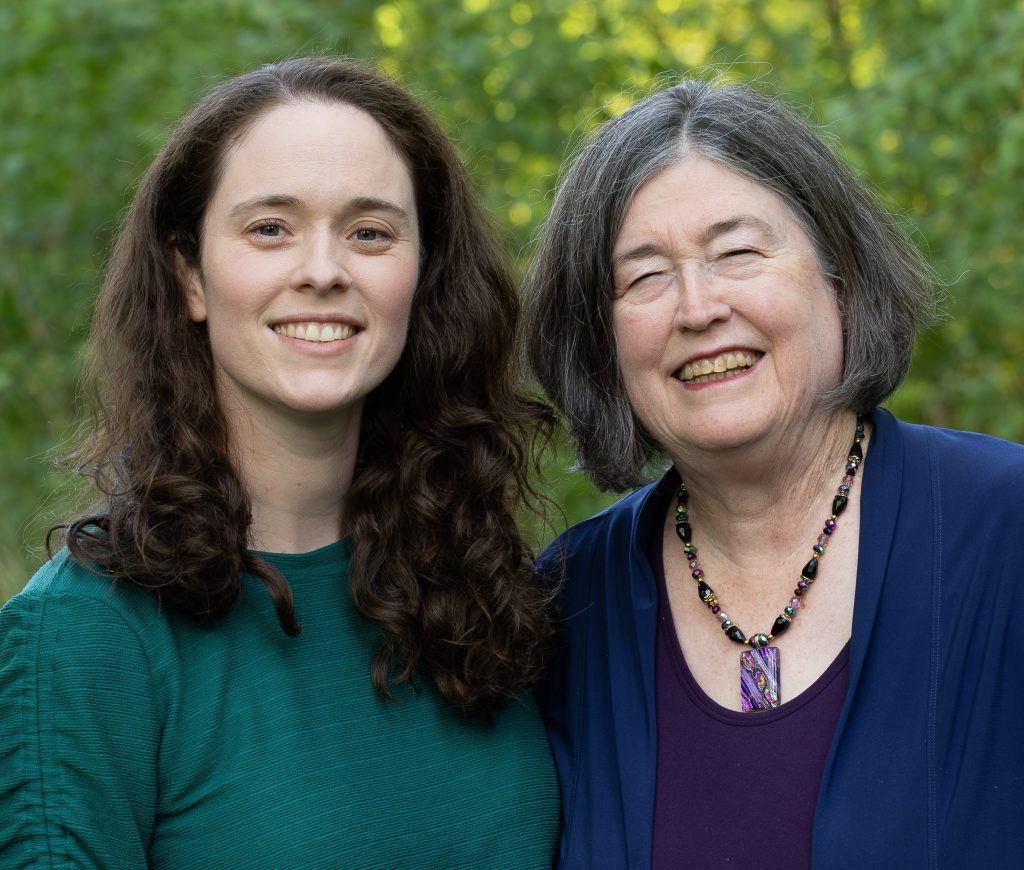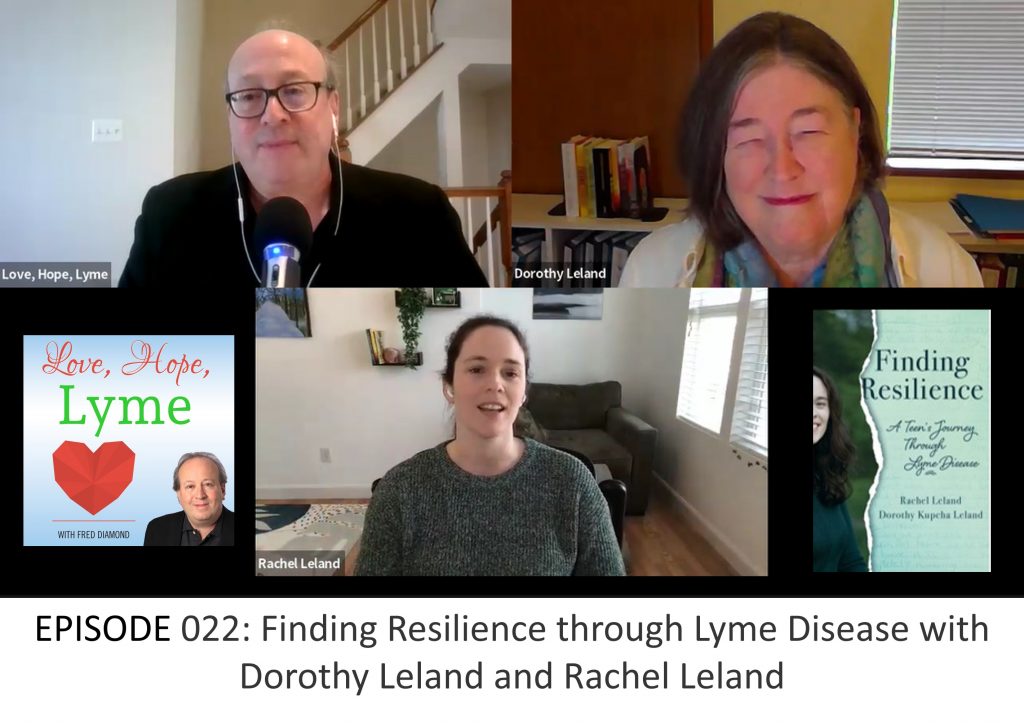PODCAST: Finding resilience through the Lyme disease journey

By Fred Diamond
On this week’s “Love, Hope, Lyme” podcast, Lymedisease.org President Dorothy Leland and her daughter Rachel Leland discuss the book they wrote together, Finding Resilience: A Teen’s Journey Through Lyme Disease.
It’s based on the journal Rachel kept during the worst years of her illness, chronicling her experience of Lyme and how it affected her family, friendships, and schooling. In Finding Resilience, Rachel’s account is interspersed with Dorothy’s insights into what was happening to their family at the same time.
When I was doing the research for my book “Love, Hope, Lyme: What Family Members, Partners, and Friends Who Love a Chronic Lyme Survivor Need to Know,” to understand what someone in my life with persistent Lyme was going through, I had no idea how much Lyme affected teenagers with the disease and the impact on their families. The Lelands do a fabulous job in the book giving insights into how they managed Rachel’s healthcare, education, and personal relationships.
Challenges with medical practitioners
Rachel’s Lyme journey started with a wrist injury during a soccer game that somehow gave rise to bodywide pain—and a host of other mysterious symptoms—that soon put her in a wheelchair. As many Lyme survivors have experienced, the first challenge is getting a proper diagnosis.
Rachel said, “It took nine months until we got the Lyme disease diagnosis after having gone to many doctors who had no idea what caused my pain. We finally found a Lyme-literate doctor and worked with him. In the next few years, it was a rollercoaster trying to heal.”
Dorothy said they started with primary care and were referred to rheumatologists and others. After someone they knew suggested it might be Lyme disease, Dorothy brought it up with the rheumatologist and they were practically thrown out of the office.
“You want to see a meltdown? Say the words Lyme disease [to a doctor]. He said there’s no Lyme disease where we lived.”
Dorothy said, “I replied, well, we don’t spend all our time here. We travel, we go other places. We hike, we camp. I was a Girl Scout leader for Rachel’s Girl Scout troop. We’d been out in the bushes.”
Meeting other families dealing with Lyme on the nascent Internet led to answers. The Lelands finally found a Lyme-knowledgeable doctor about two hours away from their home in Northern California.
Depression
Rachel said, “I was very depressed for many years. I was on medication, which was helpful to a certain extent. But I really struggled with that. I know a lot of people with Lyme struggle with depression, but the trauma of having important medical people telling me that I’m making it up, then being told that it’s her or her mother’s fault was very hard.”
Dorothy said, “Generally, doctors are taught certain ways of looking at things, in medical school and beyond. I think it’s a challenge for them to see outside of what their training has been, and the training relative to Lyme disease has been abysmal.”
She continued, “Also, Lyme disease can cause things to happen in your brain, so that part of it is in your head, but that’s not what they mean when they say it’s in your head.”
Rachel started keeping a journal
Rachel said it was important for her to document what was going on when no one knew what was happening to her, and when most people weren’t believing, especially in the medical community, what she was telling them.
She said, “I had no idea what was happening, even after the Lyme diagnosis. I started taking antibiotics, and it just seemed to keep getting worse. I spent 24/7 in my rented hospital bed in my room. I could not lay flat or sit up straight due to intense back pain and breathing problems. I needed to be at a reclined angle with my legs up and my back reclined, and that was the only place that I was even remotely okay.”
Rachel said her friends supported her through this time. “I was extremely lucky that we lived in an amazing community. All my friends stood by me. We’d play Nintendo games, play on the computer, and they’d go off to school. Then after school they would come, and they’d see me for a little bit and on the weekends. That was extremely important.”
“They all knew that I had Lyme, but it wasn’t something we usually talked about. In fact, after I’d written this memoir with my mom, all of them have been reaching out. They all said they had absolutely no idea just how bad it was. We’d play our games, watch our TV shows, just do kid stuff.”
Dorothy recalled, “Somehow, Rachel could hold it together when her friends were around, and then they’d leave, and it would all fall apart and there would be crying and angst and sometimes pounding the wall. Those girls were really an important part of the team in terms of our getting through this.”
Rachel said, “My friends were my escape, and I didn’t want to talk about that with them. We loved to film videos. That was a huge thing my friends and I did. That was something we could do from my bed.”
Dealing with schools
Dorothy is also the coauthor of “When Your Child Has Lyme Disease: A Parent’s Survival Guide.” Several chapters are devoted to school-related issues. Remote and online options were just beginning to happen at that time.
Dorothy said schools may be sympathetic when a child has a medical challenge, but their proposed solutions don’t necessarily fit the family’s needs. At one point, for example, their school district had scheduled an at-home teacher to come to their house at 9 a.m. on Wednesdays. Unfortunately, Rachel was having so much trouble sleeping (a common problem in Lyme disease), that she simply was too fatigued and brain-foggy to deal with schoolwork at that hour. As a result, Dorothy cancelled several sessions—much to the school district’s displeasure.
As Rachel approached her high school years, some school officials disputed that she even needed special arrangements. One of them told Dorothy, “You’re not going to be able to get away with this anymore.” Dorothy thought, “Really, we’re getting away with something? I thought we were just surviving.” It was problematic.
With ongoing Lyme treatment, Rachel’s brain began to clear and she was able to eventually continue her studies and ended up graduating from high school on time.
How Rachel is doing today
Rachel said, “I’m doing very well, but I must always be on top of the Lyme. If I get the flu or get something, I make sure to get nutritional IVs and do anything I need to do so that that does not become an opportunity for the Lyme to jump on it.”
I asked if they had last words of advice to others facing a similar situation.
Dorothy advised parents to listen to their child, hear what they’re saying, acknowledge it, and validate it. She also said it’s important to educate yourself about it and not necessarily believe the first thing that you’re told by the first doctor.
Rachel said, “No matter what, believe your kid or your loved one. It is very important to do things that bring you joy. When I was super sick, I would sit in my hospital bed and I had my computer on a hospital table, my keyboard and mouse on my lap, and I would edit videos and that brought me joy.”
Learn more about “Finding Resilience” here.
Click here to listen to all episodes of the Love, Hope, Lyme Podcast or on YouTube.
Fred Diamond is based in Fairfax, VA and can be contacted via Facebook. His popular book, “Love, Hope, Lyme: What Family Members, Partners, and Friends Who Love a Chronic Lyme Survivor Need to Know” is available on Amazon. The e-version of the book is always free to Lyme survivors. PM Fred on Facebook for your copy.





















We invite you to comment on our Facebook page.
Visit LymeDisease.org Facebook Page